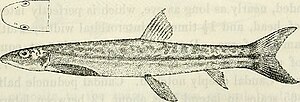Parakneria
| Parakneria | ||||||||||||
|---|---|---|---|---|---|---|---|---|---|---|---|---|

Parakneria cameronensis |
||||||||||||
| Systematics | ||||||||||||
|
||||||||||||
| Scientific name | ||||||||||||
| Parakneria | ||||||||||||
| Poll , 1965 |
Parakneria is a genus of small freshwater fish that occurs in Africa south of the equator (exception P. cameronensis in the Dja River (South Cameroon)). The main distribution areas are the Congo Basin , Katanga and Angola . The genus wassplit offfrom Kneria by the Belgian ichthyologist Max Poll and combines former Kneria species whose maleslackthe occipital organ.
features
The fish are elongated and fusiform, 6 to 15 long, and are generally even slimmer than the Kneria species. Their belly is flatter and their dorsal fin base lies in front of the pelvic fin base ; with Kneria it is above or below it. Parakneria species have a straight lateral line , while in Kneria it runs behind the pelvic fins below the lateral center line. The dorsal and anal fins are short, the caudal fin forked. A bulging of the upper gill space, the suprabranchial organ , enables the fish to breathe atmospheric oxygen. Parakneria species are inconspicuously colored in different shades of brown.
Way of life
The way of life of the Parakneria species is still largely unknown. They love currents ( rheophilous ) and occur, often together with catfish of the genus Chiloglanis , especially in fast-flowing rivers and rapids, where they can be found between stones and rubble. When looking for food, they move across the ground, hold on to their low-set pectoral and pelvic fins so that they are not washed away, and eat growth (algae) and detritus . Their reproduction is largely unknown. They may undertake spawning migrations upstream to lay their eggs there in the rainy season . Specimens of P. tanzaniae , which were caught in the rainy season in July in eastern Tanzania , had thick skin ridges that extended on both sides of the head from the mouth to the pectoral fins. They could serve to press the fish to the ground by the stronger current in the rainy season so that they do not drift away.
Types and occurrences
There are 14 types that are difficult to distinguish from one another. In some species the for accurate overlap determining important characteristics and may have been to many types described .
- Parakneria abbreviata ( Pellegrin , 1931) ; Kouilou
- Parakneria cameronensis ( Boulenger , 1909) ; Dja (South Cameroon)
- Parakneria damasi Poll , 1965 ; upper Lualaba
- Parakneria fortuita, M.J. Penrith , 1973 ; Cutato (South Angola)
- Parakneria kissi Poll, 1969 ; Lualaba
- Parakneria ladigesi Poll, 1967 ; Kwango
- Parakneria lufirae Poll, 1965 ; Lufira
- Parakneria malaissei Poll, 1969 ; Luapula
- Parakneria marmorata ( Norman , 1923) , Cuanza
- Parakneria mossambica Jubb & Bell-Cross , 1974 ; Pungwe
- Parakneria spekii ( Günther , 1868) ; Ruvu & Wami (Tanzania)
- Parakneria tanzaniae Poll, 1984 ; upper Ruaha (Tanzania)
- Parakneria thysi Poll, 1965 ; Lualaba
- Parakneria vilhenae Poll, 1965 ; Kasai
literature
- Melanie Stiassny, Guy Teugels & Carl D. Hopkins: The Fresh and Brackish Water Fishes of Lower Guinea, West-Central Africa, Volume 1. ISBN 9789074752206
- Lothar Seegers: The genus Parakneria. Pages 714 to 718, in DATZ The Aquarium and Terrarium Magazine; 11/1996, Verlag Eugen Ulmer , ISSN 1616-3222
Web links
- Parakneria on Fishbase.org (English)